1. Entrance
October 28
The man sitting behind the chain barrier between Portland, Oregon's Lownsdale Square and the Southwest Fourth Avenue sidewalk hides one side of his face behind a black cloth and nods to no one in particular. He may or may not be worried about the unequal distribution of wealth in America, but he looks completely at home at the Occupy Portland encampment sprawled between here and Chapman Square across the street.
He turns down my request for an interview – “I guess not,” he says, in a slow-motion drawl – but he's polite, reluctant, as if he wishes he could be a better host. He has no door to shut between us at a moment like this, but he starts to nod more intensely. Even in a tent city, there are ways to maintain privacy.
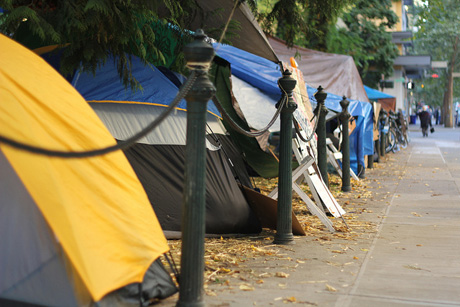
(Photo: Lance Page / Truthout)
Revolution can be awkward, especially for the media. On top of real or imagined pressures to define or interpret is the minimal obligation to accurately portray, even if something is undefinable and constantly changing.
That man's tent, and hundreds of others, are gone now. For weeks, the two parks have been nothing but empty blocks of mud and matted leaves. Evictions of Occupy camps in several cities forced much of the movement into new and often mobile forums.
But the protesters still have their voice. And as column inches and news web sites fill up with words about what their message means now that camps nationwide are gone or threatened, the photographs that captured them at their peak take on new meaning. As the poet Wallace Stevens knew and as others have echoed, sometimes images tell the story best.
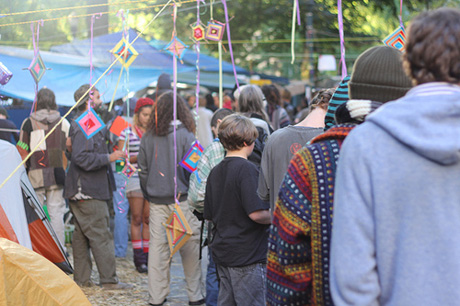
(Photo: Lance Page / Truthout)
2. The Welfare State
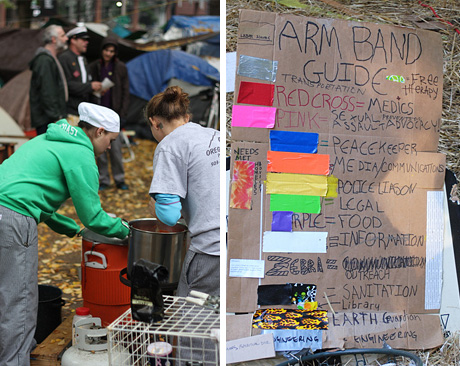
(Photos: Lance Page (left), Jared Rodriguez / Truthout)
A homeless man sits on a bench eating a free sandwich. “This is luxury,” he says. “I got a kitchen. I got a bathroom. I can sleep without the cops messing with me. This is paradise.”
Junebug, as he calls himself, says he has been homeless for 17 years. He says he prefers the camp to many of Portland's shelters, which he says open too late in the morning and don't provide enough services.
A story in one of the local weeklies quotes multiple sources who say the presence of homeless people at the camp is disruptive; that pattern has echoed in the media around the country. But Junebug says he goes to every general assembly. He wants to show me hard copies of emails about a financial conflict on the agenda at tonight's meeting. He leaves his dinner and takes me to the library tent, the legal tent, the media tent. All the copies are gone, but he takes my business card.
3. The Criminal Element
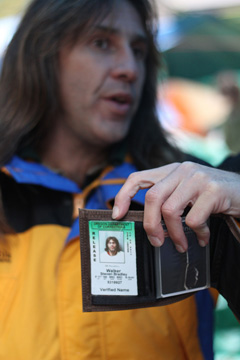
Steve “A.J.” Walker. (Photo: Lance Page / Truthout)
The Occupy camp is not a nightclub, and Steve Walker is not perched on a black leather stool checking ID's. But Walker, who goes by A.J. on the peace and safety committee he heads, has that benevolent yet threatening air and a radio on his belt, and he takes his duties seriously. He says he landed the job two days after he finished a 31-month sentence for theft and racketeering, and, volunteer or not, he plans to keep it.
Walker says addiction problems landed him in trouble with the law. Now he's sober, and he wants to work with ex-offenders as a drug and alcohol counselor. “The first thing I decided I needed to do was be successful in my transition, so when I talk to these guys, I can say, 'This is how I did it.'”
Someone passes by with a pointed rallying cry: “Are you a journalist? It's time to smoke pot.” If Walker is tempted, it doesn't show.
4. The Salesman
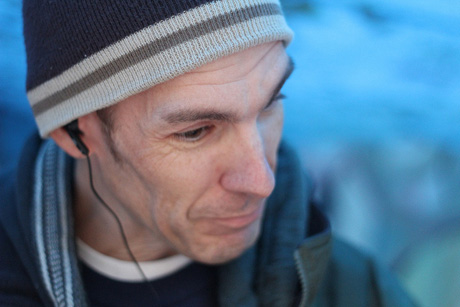
Chris Bolduc. (Photo: Lance Page / Truthout)
“I'm just trying to figure out where I fit in,” says Chris Bolduc, who walks to the camp every day from the studio he rents nearby.
“I'm on the edge right now. If it wasn't for help from my family, I'd be out here all the time,” he says. The Bay Area native says he used to sell Comcast Internet service door to door, but the 60-hour weeks and commission-only pay were barely survivable. So Bolduc quit, but he still hits the street two or three days a week for Occupy marches, delivering dissent instead of a sales pitch.
Other recent stops on Bolduc's journey: A phone call with his bank to get to the bottom of a $300 overdraft. The nearby tent of an unemployed friend who is struggling with “emotional problems.” And the street theater arrest of Condoleezza Rice for treason, sedition and war crimes. He smiles for the first time when he tells that story.
5. The Caretaker
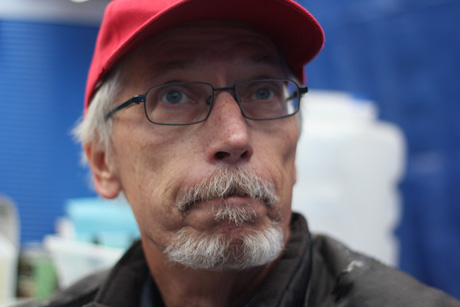
Michael Stone. (Photo: Lance Page / Truthout)
Therapist Michael Stone could charge $120 an hour if he wanted to, but he'd rather not. The licensed professional counselor gives free sessions at the camp's north end for two hours every afternoon. At his private practice, his sliding scale is $25-$55.
“I think we have to switch to kind of a creative poverty model,” says Stone. “If you have an old car, it should be applauded – not like you haven't 'made it' yet.” We should use old things, make them last longer, he says. Conserve everything. With one exception:
Stone is tired of fighting the mental health battle inside a plutocracy. “You can only do so much when the system is so corrupt. You can help people find peace in their lives, but when it's within a corrupt system? It's hard to find peace.”
6. Food

(Photo: Lance Page / Truthout)
The fire department shows up just before dinnertime and a local TV news crew is out to film the action. Safety fliers are handed out. Instructions are given. It starts to rain, and then, to rain harder.
“They're the 99 percent, too,” says one of the cooks. The red and black uniforms stand out against the semi-clean clothes of people who've been camping for weeks.
7. Clothing
A flannel-shirted man sits on an upturned box, dumping used clothing from a pillowcase into the crate in front of him. “Smell them! They're clean!” he yells, and then yells it a few more times, like someone trying to turn a profit, except he's not.

(Photo: Jared Rodriguez / Truthout)
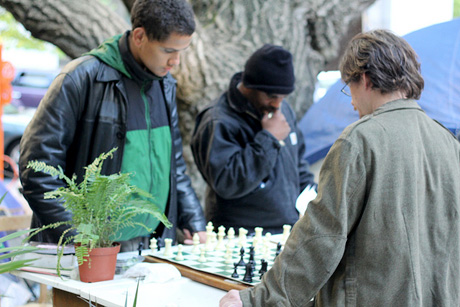
(Photo: Lance Page / Truthout)
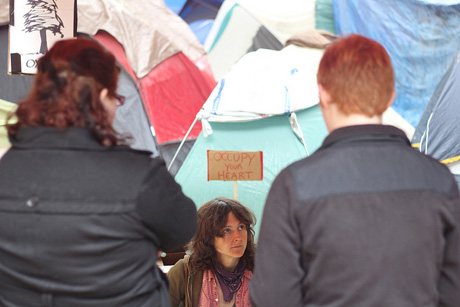
(Photo: Lance Page / Truthout)
8. Shelter
A tarp near the camp's kitchen is pitched over a bronze statue of a pioneer family – father pointing west, son holding Bible, mother holding father and son. The center of the tarp rests on the father's head. The statue is called “The Promised Land.”
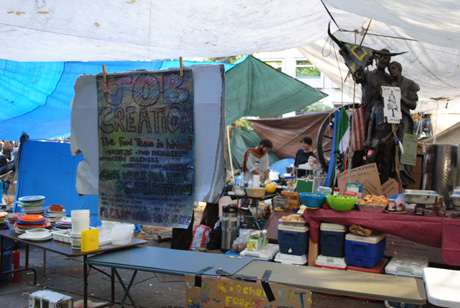
(Photo: Jared Rodriguez / Truthout)
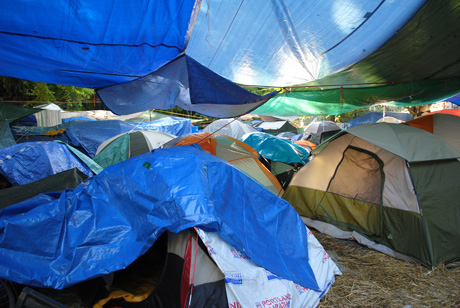
(Photo: Jared Rodriguez / Truthout)
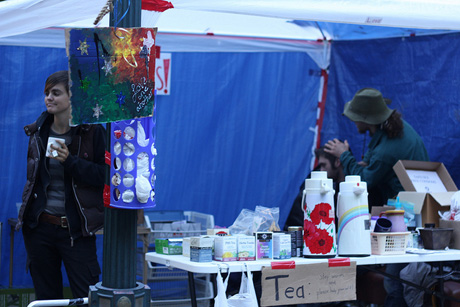
(Photo: Lance Page / Truthout)

(Photo: Jared Rodriguez / Truthout)
9. Carnival
A young, brown-haired woman stands near the water fountain. Painted whiskers extend from her nose to her cheeks. A kitten on a leash drinks from the fountain. Behind them, a woman with ginger-colored dreadlocks hoists a step stool over her head.
They could have been the subjects of an early New York Times story on the Occupy protest in Manhattan's financial district, which claimed that protesters were seizing nothing more than “the opportunity to air societal grievances as carnival.”
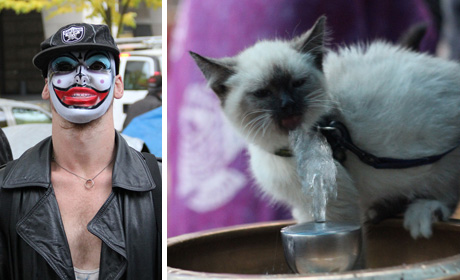
(Photos: Lance Page / Truthout)
But the cat woman's theatrical makeup is inconspicuous here. Across the walkway, a television news reporter stands motionless in an immaculate trench coat under the center of a worn tarp, waiting out the rainstorm as it draws a wet line a few feet from his polished shoes. Unless he's the master of ceremonies, he's the one who looks to be in costume.
10. The Margins of Society
According to an AP story: “In Portland, for example, protests were initially peaceful gatherings. Then the city's large number of homeless people moved in, transforming the camp into an open-air treatment center for drug addiction and mental illness.” In the experience of Stone, the professional and volunteer counselor, the division wasn't quite so neat.

(Photo: Jared Rodriguez / Truthout)

(Photo: Lance Page / Truthout)
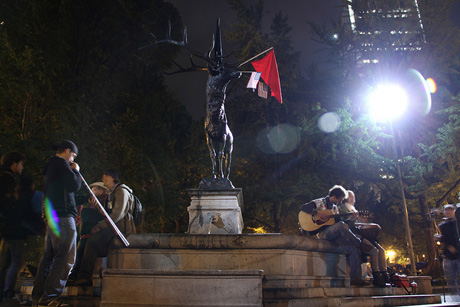
(Photo: Lance Page / Truthout)
He says he spoke with many people who appeared to be suffering from illnesses such as schizophrenia and bipolar disorder, and “the other half of what I'm doing is people coming here with stressors and life issues.” Stone also offered protesters free sessions at his regular office. He said one man took him up on it: “He was an upper-class person whose life fell apart because he lost his job and his health insurance.”
11. Anger
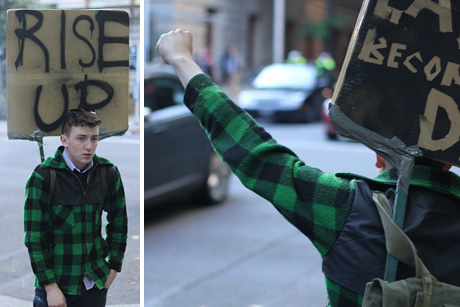
(Photos: Lance Page / Truthout)
The media tent is Junebug's last stop with me on our search for the printed emails about accusations of financial misconduct by members of the protesters' financial committee. The concerns included incorporation papers filed with the secretary of state on behalf of Occupy Portland, a decision Junebug and a media representative, Jude, say was made without the permission of the General Assembly.
The tent's copies are all out today, but the outrage is not. Junebug and Jude start to paraphrase the labyrinth of suspicions and resolutions, but in the end, Junebug throws up his hands: “How can I ask for accountability from Congress and the Senate if I can't get accountability from these motherfuckers down here?”
12. The Promised Land
November 17
A strand of barbed wire tops the chain link fencing that guards where the camp used to be. Across the barrier, the only sign of life is a woman resting her head on her husband's shoulder. He wraps his arm around her and points west while their son holds his Bible. But if this isn't the promised land, they'll never get there – the bronze family is anchored to a slab of granite.

(Photo: Lance Page / Truthout)
About a mile north of the statue, Christopher Yarrow drums on his washtub on the Steel Bridge's pedestrian walkway, timing his rhythm to a chant he learned at the Wall Street protests.
Yarrow's drumbeat echoes across the Willamette River and over the sound of the news helicopter that hovers above a crowd about a quarter mile away. About 200 people mass together to wait across the street from the bridge's westbound vehicle crossing.
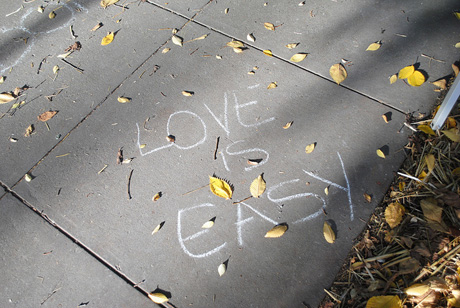
(Photo: Jared Rodriguez / Truthout)
13. Law and Order
“I'm not ready to get arrested quite yet,” says Yarrow, who has worked as an importer for ten years. “I kept my record really squeaky clean – you know, just going through airports internationally.”
The rest of the protesters will attempt to take the bridge, but they haven't moved yet. From where the crowd gathers, the view of the westbound side is blocked except for one patrol car, but 16 police officers guard the eastbound exit. Some wear riot gear, their face shields still flipped open to reveal their eyes.
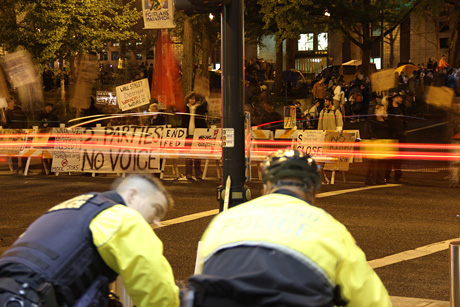
(Photo: Lance Page / Truthout)
Visit Truthout's Occupy Portland gallery on Flickr for more photos.
Matching Opportunity Extended: Please support Truthout today!
Our end-of-year fundraiser is over, but our donation matching opportunity has been extended! Today, all donations to Truthout will be matched dollar for dollar. Your one-time gift today will be matched immediately. As well, your monthly donation will be matched for the whole first year, doubling your impact.
This matching gift comes at a critical time. Trump has made it no secret that he is planning a demolition-style attack on both specific communities and democracy as a whole, beginning on his first day in office.
Help us prepare for Trump’s Day One, and have your donation matched today!
